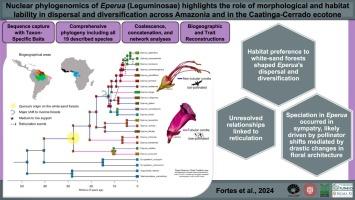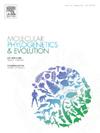Eperua(豆科)的核系统发生组学突显了栖息地和形态易变性在整个亚马孙和卡廷加--塞拉多生态区域的扩散和多样化中的作用。
IF 3.6
1区 生物学
Q2 BIOCHEMISTRY & MOLECULAR BIOLOGY
引用次数: 0
摘要
Eperua 是新热带树木的一个属,是亚马逊热带低地森林的主要组成部分,尤其是在圭亚那盾和白沙森林中。其中一个物种出现在塞拉多-卡廷加生态区,该属还栖息在河流和陆地森林中。Eperua 的物种有两种截然不同的花结构和花序类型,每种都与不同的授粉者有关。之前的 Eperua 系统发育研究显示,花结构和花序类型的拓扑结构并不稳定。此外,关于这些特征和栖息地偏好的进化如何影响 Eperua 的扩散和多样化,还没有进行过研究。通过目标捕获测序,我们推断出了迄今为止最全面的Eperua系统发生,对所有19个已知物种进行了取样,其中5个物种是首次发现。我们使用聚合、连接和网络方法来推断 Eperua 系统发生,并研究影响分辨率和支持率的不一致性来源。我们重建了花的结构、花序类型和栖息地偏好的生物地理历史和祖先状态。我们的系统发生学分析成功地解析了Eperua内部的关系,将物种树与连接树之间的冲突归因于与网状结构事件相关的基因树不一致。生物地理学分析表明,Eperua起源于圭亚那地盾的白沙森林,并在那里进行了最初的多样化。随后对河流和陆地森林的适应使Eperua得以扩展到新的栖息地和地区。不过,Eperua历来偏爱白沙森林,这可能是其在亚马逊南部和西部缺失的原因。始祖地理区域和花冠形态类型的重建表明,Eperua的物种变异发生在同域中,很可能是由授粉者的转移和花卉结构的急剧变化所引起的。本文章由计算机程序翻译,如有差异,请以英文原文为准。

Nuclear phylogenomics of Eperua (Leguminosae) highlights the role of habitat and morphological lability in dispersal and diversification across Amazonia and in the Caatinga-Cerrado ecotone
Eperua is a genus of Neotropical trees that forms a major component of tropical lowland forests in Amazonia, especially in the Guiana Shield and on white-sand forests. One species occurs in the Cerrado-Caatinga ecotone, and the genus also inhabits riverine and terra firme forests. Species in Eperua exhibit one of two drastically different floral architectures and inflorescence types, each associated with distinct pollinators. Prior phylogenetic studies of Eperua have revealed an unstructured topology concerning floral architectures and inflorescence types. In addition, no investigation has been conducted on how the evolution of these traits and habitat preferences influenced the dispersal and diversification of Eperua. Using target capture sequencing, we inferred the most comprehensive phylogeny for Eperua to date, sampling all 19 known species, five for the first time. We used coalescence, concatenation, and network methods to infer the Eperua phylogeny and investigate sources of incongruence impacting resolution and support. We reconstructed the biogeographic history and ancestral states for the flower architecture, inflorescence type, and habitat preference. Our phylogenomic analyses successfully resolved relationships within Eperua, attributing conflicts between the species tree and concatenated tree to gene tree discordance linked to reticulation events. Biogeographical analyses indicate that Eperua originated and initially diversified in the white-sand forests of the Guiana Shield. A subsequent adaptation to riverine and terra firme forests enabled Eperua to expand into new habitats and regions. Still, its historical preference for white-sand forests probably accounts for its absence in the southern and western parts of Amazonia. Ancestral geographic areas and corolla morphotype reconstructions suggest that speciation in Eperua has occurred in sympatry, likely driven by pollinator shifts mediated by drastic changes in floral architecture.
求助全文
通过发布文献求助,成功后即可免费获取论文全文。
去求助
来源期刊
CiteScore
7.50
自引率
7.30%
发文量
249
审稿时长
7.5 months
期刊介绍:
Molecular Phylogenetics and Evolution is dedicated to bringing Darwin''s dream within grasp - to "have fairly true genealogical trees of each great kingdom of Nature." The journal provides a forum for molecular studies that advance our understanding of phylogeny and evolution, further the development of phylogenetically more accurate taxonomic classifications, and ultimately bring a unified classification for all the ramifying lines of life. Phylogeographic studies will be considered for publication if they offer EXCEPTIONAL theoretical or empirical advances.

 求助内容:
求助内容: 应助结果提醒方式:
应助结果提醒方式:


